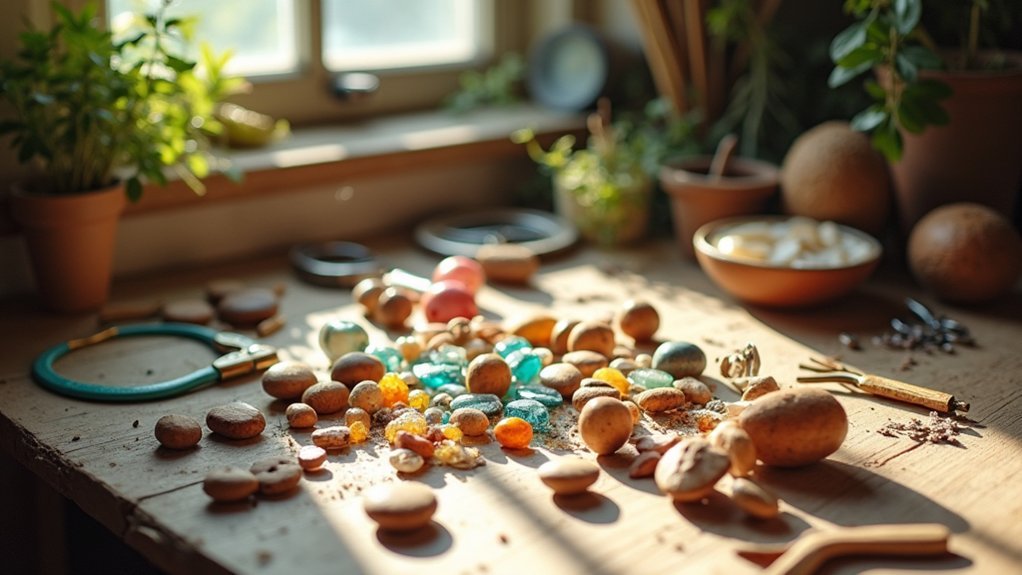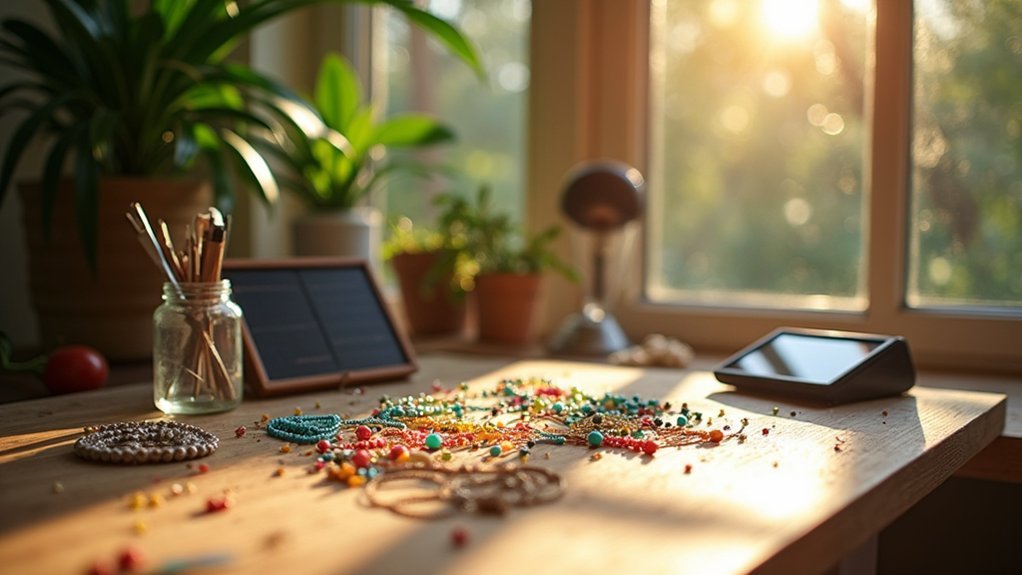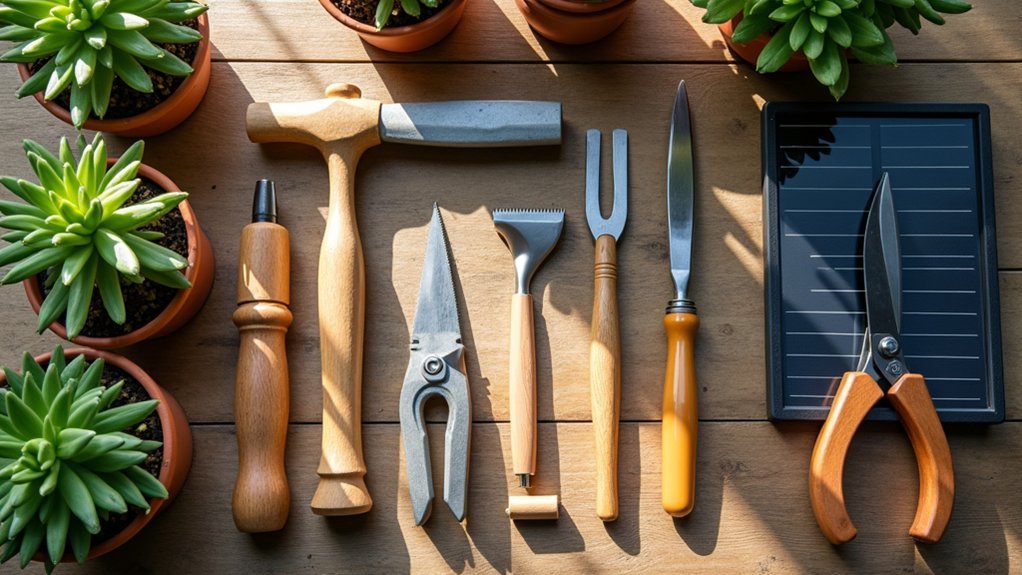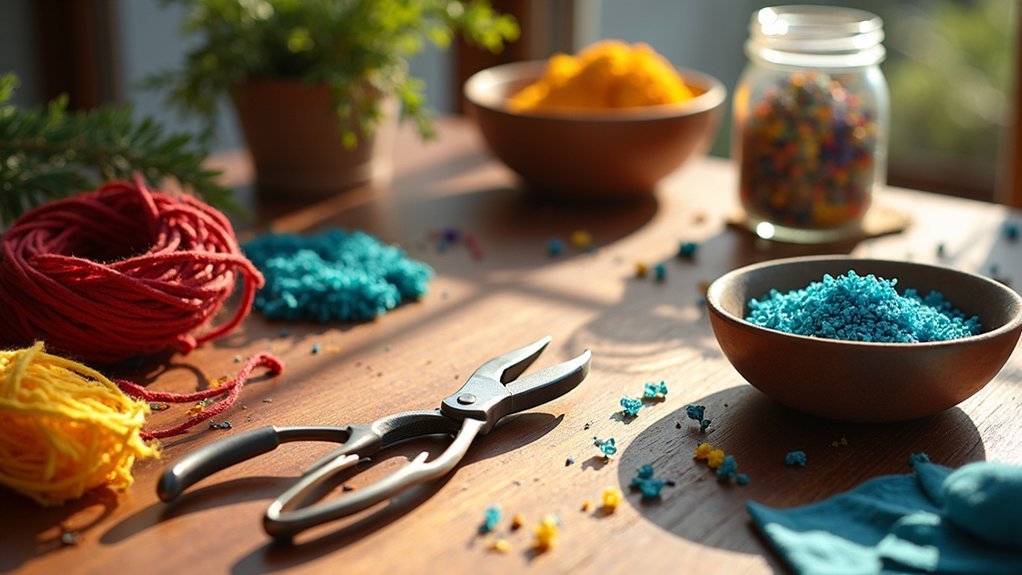You can create zero-emission accessories at home by setting up a solar-powered workspace with LED lighting and hand-powered tools. Use recycled metals like reclaimed gold and silver, laboratory-created gemstones, or biodegradable materials such as plant-based resins and responsibly harvested wood. Apply non-toxic finishes like tung oil or beeswax, and package your creations in compostable materials. Upcycle vintage jewelry pieces and source materials locally to minimize transportation emissions. These sustainable techniques will transform your crafting approach entirely.
Understanding Carbon-Neutral Materials for Jewelry Making

When you’re crafting jewelry with zero emissions in mind, choosing carbon-neutral materials becomes your foundation for sustainable accessory making.
Recycled metals like reclaimed gold and silver greatly reduce environmental impact by eliminating the need for new mining operations. These materials maintain the same quality and beauty as newly mined metals while supporting circular economy principles.
Sustainable gemstones offer another excellent option. You can choose laboratory-created stones that possess identical properties to mined gems but require considerably less environmental disruption. Alternatively, ethically sourced gems from responsible mines ensure minimal ecological damage.
Consider biodegradable materials such as natural fibers, plant-based resins, and responsibly harvested wood.
These carbon-neutral materials create unique, eco-friendly pieces that decompose safely at their lifecycle’s end, completing the zero-emission accessory goal.
Sourcing Recycled Metals and Reclaimed Gemstones
You’ll need to identify trustworthy suppliers who specialize in recycled metals and reclaimed gemstones to guarantee your accessories truly meet zero-emission standards.
Start by researching local recycling facilities, estate jewelry dealers, and certified sustainable material vendors who can provide documentation of their sourcing practices.
Before making any purchases, you must verify the authenticity and origin of these materials through proper certification and testing methods.
Finding Reliable Suppliers
Five key sourcing strategies will help you locate suppliers who provide high-quality recycled metals and reclaimed gemstones for your zero-emission accessories.
Start by exploring local scrap yards and metal recycling facilities that specialize in recycled metals. They’ll offer competitive pricing compared to new materials while supporting sustainability.
Next, browse online marketplaces dedicated to reclaimed materials where you’ll discover unique pieces for your projects.
Here’s your action plan:
- Research suppliers with eco-labels indicating sustainable practices
- Connect with environmentally-conscious jewelry makers and artisans
- Join online communities focused on sustainable crafting
- Verify certification programs that guarantee ethical procurement
These communities provide valuable supplier recommendations and sourcing tips.
You’ll build relationships with like-minded craftspeople who prioritize responsible material sourcing, giving you access to quality recycled metals and reclaimed gemstones.
Authenticating Material Origins
While establishing reliable suppliers forms the foundation of sustainable accessory creation, verifying the authenticity of your recycled metals and reclaimed gemstones guarantees you’re truly achieving zero-emission goals.
Look for certifications like the Responsible Jewelry Council (RJC) and Global Recycled Standard (GRS) to confirm material origins. These credentials validate your recycled metals have been properly reprocessed from scrap materials, saving up to 95% of energy compared to mining new metals.
In your green home workshop, you’ll want documentation proving gemstones are genuinely reclaimed from old jewelry or industrial applications.
This verification process dramatically reduces carbon emissions while conserving natural resources. Don’t accept materials without proper authentication – it’s the difference between truly sustainable accessories and greenwashing your creative efforts.
Creating Solar-Powered Jewelry Making Workstations

You’ll need to understand three key areas when building your solar-powered jewelry making workstation: the essential solar panel components that’ll power your tools, the ideal workstation design layout that maximizes both functionality and energy efficiency, and the power management systems that’ll keep everything running smoothly.
These components work together to create a sustainable workspace that can handle everything from delicate wire work to heavy-duty metalworking tasks.
Let’s examine each element to help you design a workstation that’s both environmentally responsible and professionally capable.
Essential Solar Panel Components
When setting up a solar-powered jewelry making workstation, you’ll need four core components that work together to harness and distribute clean energy effectively.
These essential elements guarantee ideal energy efficiency while powering your creative workspace sustainably.
Your solar-powered setup requires:
- Solar panels – Choose 100-300 watt panels to convert sunlight into electricity for adequate power supply.
- Charge controller – Regulates voltage and current to prevent battery overcharging and extend system lifespan.
- Deep-cycle batteries – Lithium-ion or lead-acid options store energy for cloudy days and nighttime use.
- Inverter – Converts stored DC electricity into AC power for your jewelry making tools and equipment.
Additionally, install a battery monitor to track energy consumption and battery status, helping you maintain peak performance throughout your crafting sessions.
Workstation Design Layout
Once you’ve gathered your solar components, the physical arrangement of your workstation determines both productivity and energy efficiency.
Position your panels in the sunniest area available, maximizing solar energy capture throughout the day. Place your crafting table nearby but make sure panels don’t cast shadows on your work surface.
Install energy efficient LED lighting directly above your workspace for detailed jewelry tasks.
Mount battery storage units underneath your table to save space while keeping power accessible. Arrange electric tools like soldering irons and rotary devices within arm’s reach of power outlets.
Create dedicated zones: one for cutting and shaping, another for assembly and finishing. This layout minimizes movement while maintaining clean workflow.
Maintain proper ventilation around heat-generating tools and keep sensitive components away from direct sunlight.
Power Management Systems
The heart of your solar-powered jewelry workstation lies in its power management system, which controls how energy flows from your panels to your tools.
This system maximizes renewable energy efficiency while ensuring consistent power delivery for your crafting needs.
Your power management systems should include these essential components:
- Battery storage integration – Store excess solar energy for nighttime or cloudy-day jewelry sessions
- Smart monitoring display – Track real-time energy generation and consumption patterns
- Automatic load switching – Prioritize essential tools during low-energy periods
- Energy-efficient equipment pairing – Connect LED lights and low-power soldering tools for maximum energy savings
Non-Toxic Finishing Techniques and Natural Polishing Methods

Several plant-based alternatives can replace toxic finishing products while delivering excellent protection and aesthetics for your accessories. You’ll find tung and linseed oils provide durable, non-toxic finishes that won’t compromise indoor air quality. Water-based acrylic and polyurethane options minimize VOC emissions during application.
For natural polishing, beeswax and carnauba wax create protective barriers while enhancing shine without harmful chemicals. You can make homemade furniture polish using equal parts vinegar and olive oil for effective cleaning and conditioning.
| Natural Option | Benefits |
|---|---|
| Tung Oil | Durable, food-safe finishing |
| Beeswax | Natural shine and protection |
| Water-based Polyurethane | Low VOC emissions |
| Vinegar-Olive Oil Mix | Chemical-free polishing |
| Essential Oils | Antibacterial properties |
Essential oils like lemon or lavender add pleasant scents and antibacterial properties to your finishing solutions.
Upcycling Vintage Jewelry Into Modern Designs
When you discover vintage jewelry pieces at estate sales or tucked away in family collections, you’re finding treasure troves of craftsmanship that can breathe new life into your modern wardrobe.
Vintage jewelry holds decades of artistry waiting to transform your contemporary style with timeless elegance and sustainable beauty.
Upcycling vintage jewelry transforms forgotten accessories into contemporary statement pieces while championing sustainability through creative reimagining.
Essential tools for your upcycling projects include:
- Needle-nose pliers for gripping and manipulating small components
- Wire cutters for separating elements from original settings
- Jump rings to connect different pieces together
- Additional embellishments like natural beads or recycled chains
You’ll combine components from multiple pieces—converting vintage brooches into pendants or transforming earrings into striking rings.
This process preserves historical craftsmanship while reducing waste. Market trends show growing consumer demand for upcycled accessories, creating opportunities for eco-conscious artisans.
Hand-Powered Tools and Energy-Efficient Equipment

Beyond selecting sustainable materials for your accessories, you’ll want to choose tools and equipment that minimize energy consumption throughout your crafting process. Hand-powered tools eliminate electricity and fossil fuel dependency, considerably reducing carbon emissions from your workspace. Manual drill presses, hand saws, and file sets provide precise crafting capabilities without environmental impact.
Energy-efficient equipment like LED task lighting consumes 75% less energy than traditional bulbs, dramatically shrinking your carbon footprint. Consider battery-operated tools with rechargeable batteries instead of gas-powered alternatives for heavy-duty projects.
Hand-cranked rotary tools offer dual benefits—they save energy while providing physical exercise during extended crafting sessions.
Solar-powered work lights can illuminate your workspace using renewable energy, completely eliminating grid electricity dependence for your accessory-making endeavors.
Biodegradable Packaging and Display Solutions
The final presentation of your zero-emission accessories deserves packaging that aligns with your sustainable values.
You’ll want to choose biodegradable packaging options that break down naturally, reducing landfill waste compared to petroleum-based alternatives.
Consider these sustainable packaging approaches:
- Plant-based plastics and compostable materials that decompose without harming the environment
- Recycled paper and cardboard to support a circular economy by reusing existing materials
- Renewable materials like bamboo or reclaimed wood for display solutions with lower carbon footprints
- Soy-based or water-based inks for printing that remain non-toxic during decomposition
You can also minimize material use by designing ideal shapes that reduce waste and shipping costs, making your entire presentation process truly sustainable.
Local Sourcing and Zero-Waste Studio Practices

Since transportation accounts for a significant portion of manufacturing emissions, you’ll dramatically reduce your accessory production’s carbon footprint by sourcing materials from local suppliers within your region.
Local sourcing strengthens community economies while cutting down on shipping-related pollution.
Transform your workspace into a zero-waste studio by repurposing every scrap and by-product from previous projects.
Those fabric remnants can become zipper pulls, while metal shavings work perfectly for textured finishes.
Partner with nearby artisans to exchange materials and skills, creating a collaborative network that supports sustainable practices.
Choose eco-friendly production techniques like water-based adhesives and non-toxic finishes.
Focus on sustainably harvested materials such as bamboo or recycled plastics.
This all-encompassing approach guarantees your zero-waste accessories remain environmentally responsible throughout the entire manufacturing process.
Measuring and Offsetting Your Jewelry Production Footprint
Understanding your jewelry production’s true environmental impact requires calculating emissions across three key areas: materials sourcing, energy consumption during crafting, and transportation.
You’ll achieve accurate assessments using tools like the Greenhouse Gas Protocol to track your carbon footprint systematically.
To reach zero emissions in your jewelry making, implement these essential strategies:
- Switch to renewable energy – Use solar or wind power for all electric tools and equipment during production.
- Source recycled materials – Choose sustainably mined or reclaimed metals and stones to reduce extraction energy demands.
- Create closed-loop systems – Reclaim and reuse waste materials generated during your crafting process.
- Invest in carbon offsets – Purchase carbon credits or support reforestation projects to neutralize remaining emissions.
These combined efforts guarantee your accessories achieve true zero-emission status.
Frequently Asked Questions
How to Make a Carbon-Free Home?
You’ll create a carbon-free home by installing solar panels, upgrading insulation, choosing energy-efficient appliances, implementing smart home technologies, and conducting professional energy audits to identify inefficiencies and prioritize improvements.
What Is the Cheapest Way to Create Electricity?
You’ll find solar photovoltaic panels are your cheapest electricity option, generating power at 60-70% of grid costs. You’ll recoup initial investments through tax credits and incentives while achieving long-term savings.
How Do You Make a Zero Carbon Building?
You’ll prioritize energy efficiency through exceptional insulation and airtight construction. Install renewable energy sources like solar panels, use electric heating systems, implement smart technologies, and choose sustainable materials with low embodied carbon.
Is It Possible to Make Your Own Electricity?
You can absolutely make your own electricity by installing solar panels, which generate power at 60-70% of grid costs. You’ll produce 3,000-10,000 kWh annually, considerably reducing your energy bills.
In Summary
You’ve now got the tools to create stunning accessories while protecting the planet. By choosing recycled materials, powering your workspace with solar energy, and embracing hand tools, you’re reducing your environmental impact considerably. Don’t forget to measure your footprint and offset what you can’t eliminate. Your commitment to zero-emission jewelry making proves that beautiful craftsmanship and environmental responsibility can work together seamlessly.





Leave a Reply